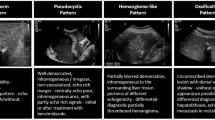Abstract
The prognosis for patients with alveolar echinococcosis of the liver (AEL) is excellent when the lesion is completely resected. Early detection of the disease and subsequent resection of the lesion are thus indispensable; however, the usefulness of screening systems is now controversial. This study was designed to compare screened and non-screened patients according to stage classification and to re-evaluate the effect of screening. We studied a total of 82 patients (63 screened and 19 non-screened). The stage classification showed a significant intergroup difference (P<0.002). The largest tumors ranged from 30 to 100 mm, and there was a significant intergroup difference (P<0.0014). Ultrasonography showed even small lesions in the screened patients. The complete resection rate was 74.6% for the screened patients, and 21.1% for the nonscreened patients, showing a significant difference (P<0.0001). The rate of unresectable lesions was higher in the non-screened patients (32%) than in the screened patients (11%), showing a significant difference (P<0.04). The present screening system contributes to early detection and subsequent resection of AEL, leading to a better outcome.
Similar content being viewed by others
References
Rausch RL. On the ecology and distribution ofEchinococcus spp. (Cestoda: Taeniidae) and characteristics of their development in the intermediate host. Ann Parasitol Hum Comp 1967;42:19–63.
Ohbayashi M. Parasitology. In: Uchino J, Sato N (eds) Alveolar echinococcosis of the liver. Sapporo: Hokkaido University Press, 1993;21–32.
Voller A, Bidwell DE, Bartlett A. Enzyme immunoassays in diagnostic medicine: Theory and practice. WHO Bull 1976;53:55–65.
Sato N, Mitamura H, Arai J, et al. Serologic diagnosis of human hydatic diseases by enzyme-linked immunosorbent assay (in Japanese with English abstract). Report of the Hokkaido Institute of Public Health 1983;33:8–15.
Furuya K, Sato N, Uchino J. Enzyme-linked immunosorbent assay (ELISA) and Western blotting (WB) test. In: Uchino J, Sato N (eds) Alveolar echinococcosis of the liver. Sapporo: Hokkaido University Press, 1993:75–91.
Nakajima Y, Sato N, Uchino J. Stage of the disease. In: Uchino J, Sato N (eds) Alveolar echinococcosis of the liver. Sapporo: Hokkaido University Press, 1993:115–119.
Kasai Y, Koshino I, Kawanishi N, et al. Alveolar echinococcosis of the liver—studies of 60 operated cases. Ann Surg 1980;191: 145–152.
Kasai Y, Sasaki E, Koshino I, et al. Operative treatment of alveolar echinococcosis of the liver. Jpn J Surg 1978;8:28–33.
Choji K, Fujita N, Chen M, et al. Alveolar hydatid disease of the liver: Computed tomography and trans-abdominal ultrasound with histopathological correlation (in Japanese with English abstract). Rinsho Hoshasen (Clin Radiol) 1992;46:97–103.
Kasai Y, Sasaki E, Tamaki A, et al. Diagnosis and surgical treatment for multilocular echinococcosis of the liver. Chir Gastroenterol 1976;10:425–428.
Gottstein B, Lengeler C, Bachmann P. Sero-epidemiological survey for alveolar echinococcosis (byEm2-ELISA) of blood donors in an endemic area of Switzerland. Trans R Soc Trop Med Hyg 1987;81:960–964.
Laplante JJ, Lenys D, Bresson-Hadni S, et al. Serological mass screening of alveolar echinococcosis in France-Comete (France). Arch Hidat 1991;30:825–829.
Caremani M, Vincenti A, Filice C, et al. Detection of hydatid cysts with echography. Survey of 242299 patients. Arch Hidatid 1991;30:277–284.
Furuya K, Sasaki S, Honma H, et al. Serologic investigations of human alveolar hydatid disease by Western blotting and indirect histo-immunoperoxidase techniques. Jpn J Parasitol 1989;38: 184–194.
Furuya K, Nishizuka M, Honma H, et al. Prevalence of human alveolar echinococcosis in Hokkaido as evaluated by Western blotting. Jpn J Med Sci Biol 1990;43:43–49.
Wilson JF, Rausch RL. Alveolar hydatid disease. A review of clinical features of 33 indigenous cases ofEchinococcus multilocularis. Am J Trop Med Hyg 1980;29:1340–1355.
Author information
Authors and Affiliations
Rights and permissions
About this article
Cite this article
Sato, N., Namieno, T., Furuya, K. et al. Contribution of mass screening system to resectability of hepatic lesions involvingEchinococcus multilocularis . J Gastroenterol 32, 351–354 (1997). https://doi.org/10.1007/BF02934492
Received:
Accepted:
Issue Date:
DOI: https://doi.org/10.1007/BF02934492




